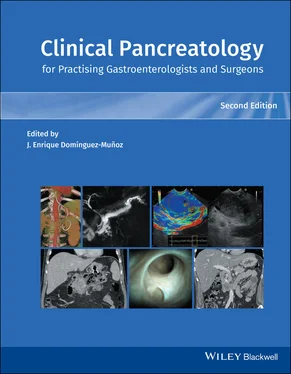60 60 Ball CG, Correa‐Gallego C, Howard TJ, et al. Radiation dose from computed tomography in patients with necrotizing pancreatitis: how much is too much? J Gastrointest Surg 2010; 14(10):1529–1535.
61 61 Brenner DJ, Hall EJ. Computed tomography: an increasing source of radiation exposure. N Engl J Med 2007; 357(22):2277–2284.
6 Role of MRI in Acute Pancreatitis : When is it Indicated and What Information can be Obtained?
Fatih Akisik
Department of Radiology and Imaging Sciences, Indiana University School of Medicine, Indianapolis, IN, USA
Acute pancreatitis is an acute inflammatory process of the pancreas that is divided into two distinct subtypes, interstitial edematous pancreatitis and necrotizing pancreatitis. This is based on the 2012 Revised Atlanta Classification, an international model used to improve communication among practitioners and increase standardization in radiology reports [1].
Magnetic resonance imaging (MRI) is a reliable and reproducible tool for diagnosis, grading, and identification of complications of acute pancreatitis. Advancement in MRI technologies, such as the use of surface phase array coils and parallel imaging, new and fast sequences such as three‐dimensional gradient echo technique (GRE) Dixon fat suppression, three‐dimensional respiratory triggering [2], and compensation sequences, have significantly improved spatial resolution and decreased total scan time [3]. Dynamic multiphase imaging after gadolinium‐based intravenous contrast administration provides invaluable information about severity of inflammation and parenchymal necrosis.
MRI is a noninvasive modality that accurately shows both parenchymal and pancreatic duct abnormalities and, in combination with magnetic resonance cholangiopancreatography (MRCP), provides comprehensive evaluation for etiologies underlying acute pancreatitis and other pancreatic diseases. MRCP sequences provide high‐resolution imaging of the pancreatic and bile ducts. They can depict duct stones as small as 2 mm in size, as well as identify congenital anomalies that may cause recurrent acute pancreatitis such as pancreas divisum and annular pancreas [4].
MRI of the pancreas using intravenous synthetic secretin hormone provides invaluable information. Secretin stimulates exocrine pancreatic secretion of bicarbonate‐rich fluid from the acinar cells of the pancreas into the duodenum, which can be imaged using fluid‐sensitive T2‐weighted MRCP sequences. Secretin enhancement improves visualization of the main pancreatic duct and associated anomalies such as pancreas divisum, subtle ductal stricture, and exocrine function of the gland [5].
MRI has multiple advantages in the setting of acute pancreatitis when compared with the use of computed tomography (CT). MRI is more sensitive than CT in identifying pancreatitis, since mild or early acute disease [6] may not change the morphology of the pancreas but can show interstitial edema that is visible as increased T2‐weighted MRI signal around the gland. This, along with supporting clinical findings, may be sufficient to make the diagnosis of acute pancreatitis.
This ability of MRI to provide excellent soft‐tissue contrast is not dependent on the use of intravenous contrast. This is especially useful in patients with renal failure, who ordinarily do not receive intravenous contrast agents during MRI or CT. Noncontrast CT has a very limited role to play in the evaluation of acute pancreatitis, and while intravenous contrast is always preferred for the evaluation of necrosis and vascular complications, noncontrast MRI can still evaluate for pancreatic edema and surrounding fluid collections with good sensitivity. In addition, one of the most common causes of acute pancreatitis is underlying gallstones, which can be diagnosed with MRCP with similar accuracy as endoscopic retrograde cholangiopancreatography (ERCP). MRCP also visualizes the biliary and pancreatic ducts to assess for ductal obstruction, abnormal duct anatomy, and stricture.
MRI and MRCP Protocol for Pancreas Examination
In our institution, we use a standard MRI and MRCP protocol for all pancreas examinations with gadolinium‐based intravenous contrast using a power injection, unless contraindicated by impaired renal function or contrast allergy. Prior to MRI examination, fasting for four to six hours reduces fluid in the stomach and decreases bowel peristalsis, both of which can cause overlying increased T2‐weighted signal that may obscure the pancreatic duct. A negative contrast agent consisting of 100–150 ml of superparamagnetic iron oxide particles can be given orally just before the examination to eliminate overlying fluid signal in the stomach and proximal small bowel segments.
We use either 1.5‐ or 3‐T MRI scanners for standard pancreas imaging. After obtaining localization sequences, pre‐contrast axial dual echo T1‐weighted GRE images with slice thickness of 6 mm are obtained to identify fatty changes, hemorrhage, and inflammation. Next, axial and coronal T2‐weighted nonfat‐suppressed breath‐hold sequences with 4‐mm slice thickness are used to identify biliary and pancreatic ductal anatomy, gallbladder, and pancreatic fluid collections. Axial fat‐suppressed T2‐weighted images are used to evaluate for pancreatic inflammation, fluid collections, and necrosis.
MRCP sequences include a three‐dimensional respiratory or a navigator‐triggered sequence, and provide high‐resolution images of the pancreatic and biliary ducts, side branches, and ductal anomalies. For secretin‐enhanced images, two‐dimensional MRCP images using a 40‐mm slab oriented with the longest axis of the main pancreatic duct are obtained.
We frequently use synthetic secretin when imaging patients with pancreatitis, although we avoid using secretin on those patients with early acute pancreatitis [7]. Secretin enhancement improves visualization of the main pancreatic duct and its anomalies such as pancreas divisum and subtle ductal stricture, and allows qualitative evaluation of pancreatic exocrine function. Coronal thick slab MRCP images are obtained after one minute intravenous administration of secretin 0.2 μg/kg. MRCP images are acquired every 30 seconds for 10 minutes. The peak effect of secretin is seen four to five minutes after administration [5] ( Table 6.1).
Interstitial Edematous Pancreatitis
Acute interstitial edematous pancreatitis (IEP) is the most common form of acute pancreatitis, found in 75% of patients. IEP consists of gland edema and inflammation, and is typically a self‐limiting disease with favorable outcomes. The parenchymal signal intensity of acute pancreatitis slightly differs from that of normal pancreatic tissue. There can also be focal or diffuse gland enlargement, and T1‐weighted images demonstrate decreased signal in the gland. T2‐weighted images using fat signal suppression are the most sensitive for edema, and show high signal fluid in a background of intermediate to low signal pancreas and low signal fat ( Figure 6.1a). The sensitivity of MRI exceeds that of CT, suggesting a role for MRI in the evaluation of patients with suspected acute pancreatitis and negative CT imaging examination [6]. Peripancreatic fat stranding is commonly seen as low signal on T1‐weighted and high signal on T2‐weighted images. In more severe forms of IEP, peripancreatic fluid collections may be seen as organized areas of increased T2 signal. IEP will also show decreased enhancement on post‐contrast images T1‐weighted images ( Figure 6.1b) [7]. MRCP images of IEP often depict no dilatation of the main pancreatic and the majority of cases show small diameter of the pancreatic duct due to parenchymal edema.
Читать дальше












